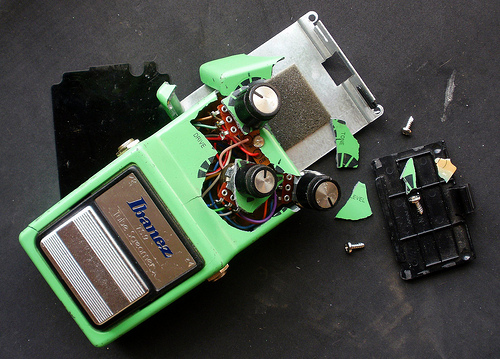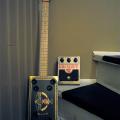 Band is all set up, seconds away from the opening chord, and you realize.. nothing coming out of your amp. Something is broken, and sh*t is about the hit the fan. People in the crowd starring at you, waiting for something awesome. You let your band mates know that something is wrong. The awkward silence of the band trying to figure out what’s happening. One of the worst feelings ever. I’m sure some of you have experienced something like this in the past. Now, it’s your turn to identify the problem, fix the problem and get back to the show. What to do?
Band is all set up, seconds away from the opening chord, and you realize.. nothing coming out of your amp. Something is broken, and sh*t is about the hit the fan. People in the crowd starring at you, waiting for something awesome. You let your band mates know that something is wrong. The awkward silence of the band trying to figure out what’s happening. One of the worst feelings ever. I’m sure some of you have experienced something like this in the past. Now, it’s your turn to identify the problem, fix the problem and get back to the show. What to do?
Before getting into this, I want to talk about my background. I program for a living, and also work on networking and systems administrations on servers. Basically, I problem solve and debug all day long. Code and computers things go wrong almost all the time, and it usually due to user/code error, but similar to the band situation, a solution needs to be discovered quickly. Downtime and programming time is costly, and the time is money as they say.
The principles I use in the computer world for debugging and problem solving I apply to almost all problem solving situation, including gear. Some of these principles could be beneficial to you as well. So let’s get started.
Start with what you know vs. what you don’t know.
What does this mean? Frankly when things go wrong, you try to grasp the possibilities of what could be causing the problem. Depending on the situation, these possibilities can be massive. In fact, the possibilities of ‘bad’ outnumbers the ‘good’. So when you realize you have no signal coming out of the amp from the guitar, to cables, to pedals, possibilities could be everything in that run of the signal. Hundreds of possible issues from electronic failure, to power, to tubes, to whatever. This is what causes the ‘death spiral’ of thinking, and leads to analysis paralysis. You basically shrug you shoulders, strum your stings.. and think.. “I don’t know.. just no sound”. Start with what you know is proving what works, and quickly identifies ‘sections’ of failure. Does your guitar work? Prove it. Plug straight into the amp. Does it work.. yes. You *know* the guitar works, you “know” the amp works and you “know” the cable works. What does that leave? Refine your process, and identify more things that you know. Knowing, also means “knowing” something is broken too. With this philosophy, you’re segmenting quickly.
I think about this often while debugging pedal circuits as well!
Start from inside to out.
I use this when I work on networking problems usually. I’ll do a quick example. You turn on your computer, you go to Google, and you get “Network timed out” or “page is not available”. My parents would call the Internet Service Provider to see what the issue is. They would walk through a bunch of test, wasting hours, that’s when you realize the network plug or wireless adapter is off on the computer. Starting from inside to out, means look at the closest things from the point of failure before going way out, and say the “internet” is broken.
Starting from inside to out with guitars, I look at the source of the sound first. That would be guitar. You know, the thing that you’re directly touching. That’s pretty close. Does the guitar work? Yes.. okay, moving further out.. go pedal to pedal. This would involve plugging direct to the amp, or bypassing the pedals directly to the amp. I’ve seen when people aren’t getting signal jump right to the amp. That’s outside.. there are a lot of things before the amp to focus on.
Know your options.
When I work on programming obstacles, I don’t want to waste too much time focusing on the main problem. AKA – banging your head against the wall. There is a point, where you need to move on to get things rolling NOW, and we can address the issue down the road. While you’re problem solving, you need to also think about the ‘worst case solution’. If you need to bypass the pedals, then that’s what you need to do, but think of these plans WHILE you’re figuring stuff out, so when it’s time to make a decision to get the show rolling, you can jump to that solution quickly. That could be borrowing and amp or guitar, play with straight signal, or removing/bypassing a bad pedal or patch/instrument cable.
Don’t make changes prior to a show.
This isn’t a problem solving, but a pro-active principle. In programming, there are some terms – “hose and go” and/or “trash and dash”. This means making a big change to code, then leaving for the afternoon, without thoroughly testing prior to promoting that code. Now, stuff is broken and the programmer is gone, and nightmare begins.
Always do changes to your board, amp, guitar, gear before rehearsals – never before a show. I know you just got that new pedal and you want to debut it for tonight’s show, but you could be introducing new variables if things don’t work properly. Is the pedal messed up? Are you drawing too much power now? Did you add new patch cables that are causing problems, etc. Don’t make your job harder on gig night.. make it easier.
So these are all easy, basic, but I’m always amazed watching bands that run into problems and have the old “deer in the headlights” look with no understanding on how to attack this problem. You just want it to work, compounded with being on stage, things can get overwhelming. Maybe some these principles can be useful to some of you.
Let me know what you think by commenting below.
-
8 years ago
Power. I always have a couple of 9v with me just in case I’m losing something just in case.
Reply -
-
8 years ago
I have an emergency backup plan and the necessary gear available when I go to a gig. I also have a couple of contingencies on how to engage my fail safe that is dependent on the scenario. The backup gear is an extra guitar, an extra amp, a versatile OD pedal, a DI and a couple of extra 10 ft and 20 ft cables. The extra guitar is self-explanatory and actually gets used depending on the music in a given set. The OD pedal is an Akai that has killer tone and full tone shaping capabilities, voicing switches, an independent built in boost fxn that is foot switchable and it has a switchable speaker emulator. It’s really more of a pedal-sized preamp. If my amp takes a crap, I can run my ax to the pedalboard, then into my “preamp” pedal, then into my DI box and then to the venue’s board or our own PA (some gigs are private affairs, so we are our own FOH and monitor sound guys sometimes). If the pedal board had issues, it’s guitar to the Akai and then to the amp. The amp has reverb that is disabled unless the board becomes non-op and then at least I still have some ambiance with the on-board reverb. I have a cable tester and can quickly Dx a bad guitar to board cable or a bad board to amp cable. The extra cables are on the stage next to my cabinet and can be swapped out. Oh, I also have a headstock tuner (which I haven’t managed to lose yet) in case the pedal board unit has issues. I have used all this gear as described and can be up and running in less than 60 seconds once I determine where the signal is not passing. I’ll look at the details at the break between sets. My emergency rig will get me through a set or a gig. I may not have use of my toys, but I can at least make a joyful noise and get the job done.
Reply -
8 years ago
Great jargon and ideas. Sometimes you have to pat yourself on the back for avoiding a classy nickname like hose and go.
Reply -
8 years ago
One friend of mine borrow a Planet Waves cable from me…..he forgot to turn the switch on before starting the intro of our show… Yes, switches are everywhere !!! ^^
Reply




